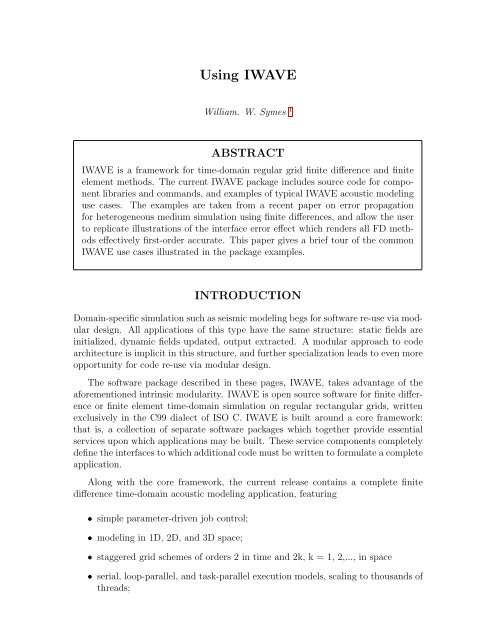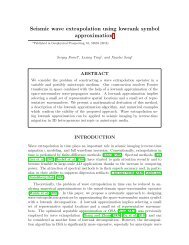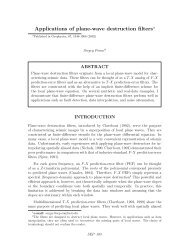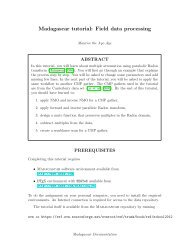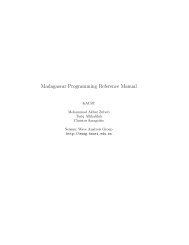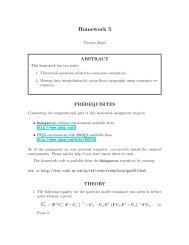Using IWAVE - Madagascar
Using IWAVE - Madagascar
Using IWAVE - Madagascar
Create successful ePaper yourself
Turn your PDF publications into a flip-book with our unique Google optimized e-Paper software.
<strong>Using</strong> <strong>IWAVE</strong><br />
William. W. Symes 1<br />
ABSTRACT<br />
<strong>IWAVE</strong> is a framework for time-domain regular grid finite difference and finite<br />
element methods. The current <strong>IWAVE</strong> package includes source code for component<br />
libraries and commands, and examples of typical <strong>IWAVE</strong> acoustic modeling<br />
use cases. The examples are taken from a recent paper on error propagation<br />
for heterogeneous medium simulation using finite differences, and allow the user<br />
to replicate illustrations of the interface error effect which renders all FD methods<br />
effectively first-order accurate. This paper gives a brief tour of the common<br />
<strong>IWAVE</strong> use cases illustrated in the package examples.<br />
INTRODUCTION<br />
Domain-specific simulation such as seismic modeling begs for software re-use via modular<br />
design. All applications of this type have the same structure: static fields are<br />
initialized, dynamic fields updated, output extracted. A modular approach to code<br />
architecture is implicit in this structure, and further specialization leads to even more<br />
opportunity for code re-use via modular design.<br />
The software package described in these pages, <strong>IWAVE</strong>, takes advantage of the<br />
aforementioned intrinsic modularity. <strong>IWAVE</strong> is open source software for finite difference<br />
or finite element time-domain simulation on regular rectangular grids, written<br />
exclusively in the C99 dialect of ISO C. <strong>IWAVE</strong> is built around a core framework:<br />
that is, a collection of separate software packages which together provide essential<br />
services upon which applications may be built. These service components completely<br />
define the interfaces to which additional code must be written to formulate a complete<br />
application.<br />
Along with the core framework, the current release contains a complete finite<br />
difference time-domain acoustic modeling application, featuring<br />
• simple parameter-driven job control;<br />
• modeling in 1D, 2D, and 3D space;<br />
• staggered grid schemes of orders 2 in time and 2k, k = 1, 2,..., in space<br />
• serial, loop-parallel, and task-parallel execution models, scaling to thousands of<br />
threads;
2<br />
• flexible specification of PML absorbing or pressure-release boundary conditions<br />
on all faces of the simulation cube;<br />
• arbitrary source and receiver locations, and flexible point and array source specification<br />
including simultaneous source modeling (random, plane-wave,...)<br />
• standard input and output data formats (SEGY, RSF)<br />
An isotropic elastic modeling application with similar features, and built around the<br />
same core framework, has been developed and will be included in a forthcoming<br />
release.<br />
The primary purpose of this short paper is to illustrate the use of <strong>IWAVE</strong> to<br />
calculate synthetic acoustic seismograms. To that end, the paper describes a simple<br />
application - 2D synthetic seismogram generation over a simple structural model of the<br />
sedimentary column - and provides a set of demonstration examples (“demos”) which<br />
the reader may reproduce, along with complete annotation of the files needed for job<br />
specification and sample graphics derived from the results (as well as commands to<br />
produce these graphics).<br />
A secondary purpose is to supply the user with the means to independently verify<br />
some of the claims in the paper by Symes and Vdovina (2009), namely the existance<br />
of an error component in synthetic data derived from strongly heterogeneous models,<br />
in addition to the well-known grid dispersion error. The examples presented here are<br />
essentially the same as those presented in that paper. By installing <strong>IWAVE</strong> and running<br />
the demonstrations described here, the reader may reproduce the computational<br />
content of (Symes and Vdovina, 2009).<br />
<strong>IWAVE</strong> is both a standalone application, and a component of the <strong>Madagascar</strong> software<br />
suite (Fomel, 2009) The application package and the examples discussed here<br />
(and indeed this paper itself) may be built either independently, or within <strong>Madagascar</strong>,<br />
as explained in detail below.<br />
<strong>IWAVE</strong> was used in a quality control role in the SEAM Phase I project - see<br />
Fehler and Keliher (2011) for an account, including discussion of the many difficulties<br />
of large scale numerical simulation of seismograms.<br />
The internal details of <strong>IWAVE</strong> are not discussed here, except insofar as is necessary<br />
to explain the use of the main commands. Symes et al. (2011) briefly describe<br />
the structure of the <strong>IWAVE</strong> framework, with emphasis on its object-oriented design<br />
and the resulting mechanisms for coupling modeling with optimization packages to<br />
produce inversion applications. The <strong>IWAVE</strong> project web page (Terentyev et al., 2012)<br />
provides extensive reference material, and further information about the design.<br />
The paper begins with a brief review of the system of partial differential equations<br />
solved (approximately) by <strong>IWAVE</strong>’s acoustic application, and the choice of finite<br />
difference method. The following section presents the examples of Symes and Vdovina<br />
(2009), along with some additional examples based on the same distribution of
3<br />
mechanical parameters which shed light on the impact of finite difference order on<br />
solution accuracy. Instructions for recreating these examples follow. The paper ends<br />
with a brief discussion of the prospects for improvements in performance and accuracy<br />
in FD technology, and the evolutionary advantages flowing from the modular,<br />
or object, orientation of <strong>IWAVE</strong>. Two appendices describe the job parameters used<br />
in the examples, and download and install instructions.<br />
ACOUSTODYNAMICS<br />
The <strong>IWAVE</strong> acoustics application is based on the pressure-velocity form of acoustodynamics,<br />
consisting of two coupled first-order partial differential equations:<br />
ρ ∂v<br />
= −∇p (1)<br />
∂t<br />
1 ∂p<br />
= −∇ · v + g (2)<br />
κ ∂t<br />
In these equations, p(x, t) is the pressure (excess, relative to an ambient equilibrium<br />
pressure), v(x, t) is the particle velocity, ρ(x) and κ(x) are the density and particle<br />
velocity respectively. Bold-faced symbols denote vectors; the above formulation<br />
applies in 1, 2, or 3D.<br />
The inhomogeneous term g represents externally supplied energy (a “source”), via<br />
a defect in the acoustic constitutive relation. A typical example is the isotropic point<br />
source<br />
g(x, t) = w(t)δ(x − xs)<br />
at source location xs.<br />
Virieux (1984) introduced finite difference methods based on this formulation of<br />
acoustodynamics to the active source seismic community. Virieux (1986) extended<br />
the technique to elastodynamics, and Levander (1988) demonstrated the use of higher<br />
(than second) order difference formulas and the consequent improvement in dispersion<br />
error. <strong>IWAVE</strong>’s acoustic application uses the principles introduced by these authors<br />
to offer a suite of finite difference schemes, all second order in time and of various<br />
orders of accuracy in space.<br />
The bulk modulus and buoyancy (reciprocal density) are the natural parameters<br />
whose grid samplings appear in the difference formulae. I will display velocity and<br />
density instead in the examples below. <strong>IWAVE</strong>’s acoustic application converts velocity<br />
and density to bulk modulus and buoyancy as part of the problem setup phase;<br />
the user may supply any equivalent combination of parameters.<br />
EXAMPLES BASED ON A 2D DOME MODEL<br />
This simple 2D model embeds an anticline or dome in an otherwise undisturbed<br />
package of layers. The velocity and density models are depicted in Figures 1 and
4<br />
2. These figures display sampled versions of the models with ∆x = ∆z = 5 m; the<br />
model fields are actually given analytically, and can be sampled at any spatial rate.<br />
Symes and Vdovina (2009) use this model to illustrate the interface error phenomenon:<br />
the tendency, first reported by Brown (1984), of all finite difference schemes<br />
for wave propagation to exhibit first order error, regardless of formal order, for models<br />
with material parameter discontinuities. Figure 3 exhibits a shot gather, computed<br />
with a (2,4) (= 2nd order in time, 4th order in space) staggered grid scheme,<br />
∆x = ∆z = 5 m and an appropriate near-optimal time step, acquisition geometry<br />
as described in caption. The same gather computed at different spatial sample<br />
rates seem identical, at first glance, however in fact the sample rate has a considerable<br />
effect. Figures 4 and 5 compare traces computed from models sampled at four<br />
different spatial rates (20 m to 2.5 m), with proportional time steps. The scheme<br />
used is formally 2nd order convergent like the original 2nd order scheme suggested<br />
by Virieux (1984), but has better dispersion suppression due to the use of 4th order<br />
spatial derivative approximation. Nonetheless, the figures clearly show the first order<br />
error, in the form of a grid-dependent time shift, predicted by Brown (1984).<br />
Generally, even higher order approximation of spatial derivatives yields less dispersive<br />
propagation error, which dominates the finite difference error for smoothly<br />
varying material models. For discontinuous models, the dispersive component of error<br />
is still improved by use of a higher order spatial derivative approximation, but<br />
the first order interface error eventually dominates as the grids are refined. Figure 6<br />
shows the same shot gather as displayed earlier, with the same spatial and temporal<br />
sampling and acquisition geometry, but computed via the (2,8) (8th order in space)<br />
scheme. The two gather figures are difficult to disinguish. The trace details (Figures<br />
7, 8) show clearly that while the coarse grid simulation is more accurate than the<br />
(2,4) result, but the convergence rate stalls out to 1st order as the grid as refined,<br />
and for fine grids the (2,4) and (2,8) schemes produce very similar results: dispersion<br />
error has been suppressed, and what remains is due to the presence of model<br />
discontinuities.<br />
See (Symes and Vdovina, 2009) for more examples, analysis, and discussion, also<br />
(Fehler and Keliher, 2011) for an account of consequences for quality control in largescale<br />
simulation.<br />
CREATING THE EXAMPLES - RUNNING <strong>IWAVE</strong><br />
APPLICATIONS<br />
<strong>IWAVE</strong> builds with SConstruct (http://www.scons.org), either as an independent<br />
package or as part of <strong>Madagascar</strong> (Fomel, 2009). For download and install instructions,<br />
see Appendix B and sources cited there.<br />
The examples are also scripted with SConstruct. Providing scripts makes the<br />
results convenient to rebuild, and I’ll first explain how to do that. I also explain how
5<br />
one uses the basic <strong>IWAVE</strong> commands from the command line, outside the context of<br />
these examples.<br />
Scripted Examples<br />
To build the intermediate data and figures for the examples described here,,<br />
• install <strong>IWAVE</strong>, either within <strong>Madagascar</strong> or standalone. I will use $TOP to<br />
denote the path to the top-level <strong>IWAVE</strong> directory for the standalone version,<br />
or to the top-level <strong>Madagascar</strong> build directory $RSFSRC.<br />
• for the standalone version of <strong>IWAVE</strong>, the examples build with the assistance of<br />
SU, which must also be installed. The choice of word order in <strong>IWAVE</strong> and SU<br />
must be compatible: either the XDR option must be set in both, or in neither.<br />
Default for both <strong>IWAVE</strong> and SU is native binary word order. To set the XDR<br />
option for SU, follow instructions in Makefile.config; for <strong>IWAVE</strong>, configure<br />
compilation with the flag -DSUXDR, as described in Appendix B and (Terentyev<br />
et al., 2012).<br />
• the <strong>Madagascar</strong> version builds with entirely with <strong>Madagascar</strong> commands, so no<br />
external package need be supplied.<br />
• build data and figures: in the standalone version of <strong>IWAVE</strong>,<br />
– cd $TOP/demo/data<br />
– scons<br />
, or, in the <strong>Madagascar</strong> version,<br />
– cd $TOP/book/trip/iwave/data<br />
– scons<br />
– scons lock -f madfig.sc<br />
(the last step is necessary only if you wish to build a copy of this paper from<br />
source - it archives the newly created figures and makes them available to the<br />
paper build, as described in the next bullet)<br />
• to (re)build this paper, build the figures first. Then in the standalone version,<br />
– cd $TOP/papers<br />
– scons<br />
or, in the <strong>Madagascar</strong> version,<br />
– cd $TOP/book/iwave
– scons<br />
6<br />
Note that the finest (2.5 m) grid consists of roughly 10 million gridpoints. Consequently<br />
the modeling runs collectively take a considerable time, from a minutes to a<br />
substantial fraction of an hour depending on platform, on a single thred. This example<br />
is computationally large enough that parallelism via domain decomposition is<br />
worthwhile. <strong>IWAVE</strong> is designed from the ground up to support parallel computation;<br />
a companion report will demonstrate parallel use of <strong>IWAVE</strong>.<br />
Inspection of the SConstruct file in data will show that the modeling tool used<br />
is $TOP/asg/main/asg.x, the <strong>IWAVE</strong> acoustic modeling command (in <strong>Madagascar</strong><br />
Flows, this command is referenced simply as asg, which is an alias for $RSFROOT/bin/sfasg,<br />
where $RSFROOT is an alias for the <strong>Madagascar</strong> install directory). Input data is supplied<br />
by a parameter list, stored in a file. The model-building tool standardmodel<br />
builds the velocity and density model files, and works the same way - many of the<br />
parameter files in the data directory are input for this tool.<br />
Both the <strong>IWAVE</strong> acoustic modeling command and standardmodel self-doc in the<br />
style of SU or <strong>Madagascar</strong>. For modeling command, the self-doc is deprecated in<br />
favor of the web documentation mentioned above.<br />
<strong>Using</strong> <strong>IWAVE</strong> commands in other contexts<br />
To use the acoustic modeling command outside of the scripted examples, the user<br />
needs to create a parameter list. The job parameters for the use case of the scripted<br />
examples are described in detail in Appendix A. The html documentation (Terentyev<br />
et al., 2012) describes other parameter choices, corresponding the wide variety of<br />
use cases accommodated by this application. Key parameters are pathnames to the<br />
model data files (velocity and density, or equivalent parameters) and to seismic trace<br />
files containing prototype output trace headers and (possibly) source pulse traces,<br />
and output traces on normal completion.<br />
The acoustic application currently expect model data files in the RSF format of<br />
<strong>Madagascar</strong> (Fomel, 2009). The scripts use standardmodel to store gridded model<br />
data in RSF format, and data from other sources will need conversion to this format.<br />
An RSF data set consists of two files, an ascii header (grid metadata) file and a<br />
flat binary data file. The data set is referenced by the header file name; one of the<br />
parameters listed in the header file is the pathname of the binary data file, with key in.<br />
The header file is small and easily created by hand with an editor, if necessary. Many<br />
archival data formats make the grid sample values available as a flat binary file - this is<br />
true for instance of the gridded models output by GOCAD (http://www.gocad.org),<br />
for which the vo files contain virtually the same information as (so may easily be<br />
translated to) RSF header files in ascii form, and the vodat files are flat binary files<br />
which may be used unaltered as RSF binary files.<br />
By convention, the dimension of the problem is that of the primary model grid,
7<br />
that associated with the bulk modulus data, if it is given, or failing that, the velocity.<br />
This grid is also the primary grid of the simulation: that is, the space steps used in<br />
the finite difference method are precisely those of the bulk modulus, or velocity, data.<br />
Thus the choice of simulation grid is made externally to <strong>IWAVE</strong>.<br />
The <strong>IWAVE</strong> acoustic application uses specific internal scales - m/ms for velocity,<br />
g/cm 3 for density, and corresponding units for other parameters. To ensure that<br />
data in other (metric) units are properly scaled, the RSF header file should specify<br />
a value for the scale key, equal to the power of 10 by which the data should be<br />
multiplied on being read into the application, to convert to the internal scale. For<br />
example, if velocities are given in m/s, the header file should include the line scale<br />
= -3. In forthcoming releases, this device will be deprecated in favor of explicit unit<br />
specifications.<br />
One of <strong>IWAVE</strong>’s design criteria is that acquisition geometry parameters should<br />
have no a priori relation to the computational grid geometry: source and receiver<br />
locations may be specified anywhere in Euclidean space. The current release accepts<br />
a SU (SEGY without reel header) format data file specified by the hdrfile keyword:<br />
the trace headers in this file are those of the output (pressure) traces. Units of length<br />
and time are m and ms respectively, consistent with other internal unit choices. The<br />
example scripts use SU or <strong>Madagascar</strong> commands to create these prototype trace<br />
files.<br />
The source pulse may be specified as a Ricker wavelet, or read from another SU<br />
file, whose pathname is the value associated with the source keyword. Source calibrarion<br />
is regulated by several other keywords, as described in Appendix A. In the<br />
examples, the Ricker option is used, simply because it avoids some small incompatibilities<br />
between SU and <strong>Madagascar</strong> filter implementations which would otherwise<br />
prevent the standalone and <strong>Madagascar</strong> versions of the examples from generating the<br />
same pulses, and therefore prevent the results from matching precisely.<br />
Because the number of parameters describing a simulation task is reasonably large<br />
(roughly 15 in a simple case), the job parameters for <strong>IWAVE</strong>’s acoustic application<br />
are most conveniently stored in a file, passed to the application via a command line<br />
parameter. Denoting by $ASG either $TOP/asg/main/asg.x for the standalone implementation,<br />
or $RSFROOT/bin/sfasg for the <strong>Madagascar</strong> install, the proper command<br />
takes the form<br />
[prefix] $ASG par=[parfile].<br />
Here [prefix] is any necessary command prefix, eg. mpirun ..., and [parfile] is<br />
the pathname of the parameter file. On successful completion, the output data will<br />
be stored in a file (SU format) indicated by the key datafile in the parameter file.
8<br />
DISCUSSION AND CONCLUSION<br />
The rather large and only slowly disappearing error revealed by the examples from<br />
Symes and Vdovina (2009) suggests strong limits for the accuracy of regular grid<br />
finite difference methods. Finite element methods suffer from the same limitations:<br />
accurate solution of acoustodynamic or elastodynamic problems appears to demand<br />
interface-fitted meshed (Cohen, 2002), with the attendant increase in code and computational<br />
complexity.<br />
The situation may not be so bleak, however. For one special case, namely constant<br />
density acoustics, Terentyev and Symes (2009) show that a regular grid finite<br />
difference method, derived from a regular grid Galerkin finite element method, has<br />
accuracy properties one would expect in homogeneous media (second order convergence,<br />
reduction of grid dispersion through higher order space differencing) even for<br />
discontinuous models: the interface error effect is attenuated. This type of result<br />
actually goes quite far back in computational geophysics (see for example Muir et al.<br />
(1992)), though theoretical support has been slower in coming.<br />
Pure regular grid methods cannot take advantage of changes in average velocity<br />
across the model, and concommitant changes in wavelength. Coupling of local<br />
regular grids is possible, however, and can yield substantial computational efficiency<br />
through grid coarsening in higher velocity zones - see Moczo et al. (2006). <strong>IWAVE</strong><br />
already accommodates multiple grids (in domain decomposition parallelism), and<br />
extension to incommensurable multiple grids would be a significant change, but in<br />
principle straightforward. The use of logically rectangular but geometrically irregular<br />
(“stretched”) grids is completely straightforward, on the other hand.<br />
These and other extensions, both past and future, are eased by the reusability<br />
designed into the <strong>IWAVE</strong> core framework. This design has produced reasonably wellperforming<br />
and easy-to-use applications, and has proven extensible to new models<br />
and schemes. Moreover, as explained by Symes et al. (2011), the object-oriented<br />
design of <strong>IWAVE</strong> dovetails with similarly designed optimization software to support<br />
the construction of waveform inversion software. The inversion applications resulting<br />
from this marriage inherit the features of <strong>IWAVE</strong> - parallel execution, high-order<br />
stencils, efficient boundary conditions, simple job control - without requiring that<br />
these aspects be reworked in the code extensions.<br />
The <strong>IWAVE</strong> acoustic application supports many use cases beyond those of the<br />
scripted examples, such as various modes of parallel execution, array sources, movie<br />
output, 3D modeling, and many others described in the documentation. It is hoped<br />
that the brief overview above, the detailed description of the example parameters<br />
given in Appendix A, and the much more extensive description of use cases in (Terentyev<br />
et al., 2012) will enable the reader to constuct a wide variety of synthetic data<br />
sets with relative ease.
9<br />
ACKNOWLEDGEMENTS<br />
<strong>IWAVE</strong> has been a team effort: the original design of the core framework is due<br />
to Igor Terentyev, and Tanya Vdovina, Dong Sun, Marco Enriquez, and Xin Wang<br />
have each made major contributions. Development of <strong>IWAVE</strong> was supported by the<br />
SEG Advanced Modeling (SEAM) project, by the National Science Foundation under<br />
awards 0620821 and 0714193, and by the sponsors of The Rice Inversion Project. The<br />
<strong>IWAVE</strong> project owes a great deal to several open source seismic software packages<br />
(Seismic Un*x, SEPlib, <strong>Madagascar</strong>), debts which we gratefully acknowledge. The<br />
author wishes to record his special gratitude to Sergey Fomel, the architect of <strong>Madagascar</strong>,<br />
for his inspiring ideas and his generous and crucial help in the integration of<br />
<strong>IWAVE</strong> into <strong>Madagascar</strong>.<br />
REFERENCES<br />
Brown, D., 1984, A note on the numerical solution of the wave equation with piecewise<br />
smooth coefficients: Mathematics of Computation, 42, 369–391.<br />
Cohen, G. C., 2002, Higher order numerical methods for transient wave equations:<br />
Springer.<br />
Fehler, M., and P. J. Keliher, 2011, SEAM Phase I: Challenges of subsalt imaging in<br />
tertiary basins, with emphasis on deepwater gulf of mexico: Society of Exploration<br />
Geophysicists. (eISBN=9781560802884, eBook catalog number 114E).<br />
Fomel, S., 2009, <strong>Madagascar</strong> web portal: http://www.reproducibility.org, accessed<br />
5 April 2009.<br />
Levander, A., 1988, Fourth-order finite-difference P-SV seismograms: Geophysics,<br />
53, 1425–1436.<br />
Moczo, P., J. O. A. Robertsson, and L. Eisner, 2006, The finite-difference time-domain<br />
method for modeling of seismic wave propagation: Advances in Geophysics, 48,<br />
421–516.<br />
Muir, F., J. Dellinger, J. Etgen, and D. Nichols, 1992, Modeling elastic fields across<br />
irregular boundaries: Geophysics, 57, 1189–1196.<br />
Symes, W. W., D. Sun, and M. Enriquez, 2011, From modelling to inversion:<br />
designing a well-adapted simulator: Geophysical Prospecting, 59, 814–833.<br />
(DOI:10.1111/j.1365-2478.2011.00977.x).<br />
Symes, W. W., and T. Vdovina, 2009, Interface error analysis for numerical wave<br />
propagation: Computational Geosciences, 13, 363–370.<br />
Terentyev, I., and W. W. Symes, 2009, Subgrid modeling via mass lumping in constant<br />
density acoustics: Technical Report 09-06, Department of Computational and<br />
Applied Mathematics, Rice University, Houston, Texas, USA.<br />
Terentyev, I., T. Vdovina, X. Wang, and W. W.<br />
Symes, 2012, <strong>IWAVE</strong>: a framework for wave simulation:<br />
http://www.trip.caam.rice.edu/software/iwave/doc/html/index.html, accessed 21<br />
Sept 2012.
10<br />
Virieux, J., 1984, SH-wave propagation in heterogeneous media: Velocity stress finitedifference<br />
method: Geophysics, 49, 1933–1957.<br />
——–, 1986, P-SV wave propagation in heterogeneous media: Velocity stress finitedifference<br />
method: Geophysics, 51, 889–901.<br />
Figure 1: Dome velocity model<br />
ANNOTATED PARAMETER FILES<br />
All <strong>IWAVE</strong> applications are parameter-driven: that is, they accept as input a map<br />
or associative array, defined by a list of key = value pairs. These parameter specifications<br />
can be included on the command line. However, because the number of such<br />
parameter specifications is rather large, it’s convenient to store them in a parameter<br />
file (“par file”). The use of a par file has the added advantage that the file may<br />
include annotations and white space to improve readability.<br />
The examples displayed in this paper are created in the directory $TOP/demo/data.<br />
The par file parfile is a by-product of data creation - the SConstruct script textprocesses<br />
it from prototype files including macros, which are resolved when the scripts<br />
are run. Four such prototype par files are present in data, each one defining a
11<br />
Figure 2: Dome density model
12<br />
Figure 3: 2D shot record, (2,4) staggered grid scheme, ∆x = ∆z = 5 m, appropriate<br />
∆t, 301 traces: shot x = 3300 m, shot z = 40 m, receiver x = 100 - 6100 m, receiver z<br />
= 20 m, number of time samples = 1501, time sample interval = 2 ms. Source pulse<br />
= zero phase trapezoidal [0.0, 2.4, 15.0, 20.0] Hz bandpass filter.
13<br />
Figure 4: Trace 100 (receiver x = 2100 m) for ∆x = ∆z = 20 m (black), 10 m (blue),<br />
5 m (green), and 2.5 m (red). Note arrival time discrepancy after 1 s: this is the<br />
interface error discussed in (Symes and Vdovina, 2009). Except for the 20 m result,<br />
grid dispersion error is minimal.
14<br />
Figure 5: Trace 100 detail, 1.8-2.5 s, showing more clearly the first-order interface<br />
error: the time shift between computed events and the truth (the 2.5 m result, more<br />
or less) is proportional to ∆t, or equivalently to ∆z.
15<br />
Figure 6: 2D shot record, (2,8) scheme, other parameters as in Figure 3.
16<br />
Figure 7: Trace 100 computed with the (2,8) scheme, other parameters as described<br />
in the captions of Figures 3 and 4.
17<br />
Figure 8: Trace 100 detail, 1.8-2.5 s, (2,8) scheme.. Comparing to Figure 5, notice<br />
that the dispersion error for the 20 m grid is considerably smaller, but the results for<br />
finer grids are nearly identical to those produced by the (2,4) grids - almost all of the<br />
remaining error is due to the presence of discontinuities in the model.
18<br />
modeling task corresponding to a given level of grid refinement. The actual input to<br />
the modeling command is parfile.<br />
The meaning of each parameter in the par file is described in the <strong>IWAVE</strong> web<br />
documentation (Terentyev et al., 2012). This appendix gives a brief description of<br />
the parameter assignments appearing in the parfile generated for the 20 m grid<br />
example. To run this example, and coincidentally generate its parameter file,<br />
• cd $TOP/demo/data<br />
• scons demo20m<br />
The file parfile groups job parameters into blocks. The first block looks like<br />
this:<br />
INPUT DATA FOR iwave<br />
------------------------------------------------------------------------<br />
FD:<br />
order = 2 spatial half-order<br />
cfl = 0.4 proportion of max dt/dx<br />
cmin = 1.0<br />
cmax = 4.5<br />
dmin = 0.5<br />
dmax = 5.0<br />
fpeak = 0.010 central frequency<br />
Note that comments, block labels, and typographical separators are all accommodated.<br />
The <strong>IWAVE</strong> parameter parser identifies parameter specifications by strings of<br />
the form<br />
key = value<br />
consisting of a string with no embedded whitespace, followed by an = sign surrounded<br />
by any amount of whitespace on either side, followed by another string with no embedded<br />
whitespace. Strings with embedded whitespace are also allowed, provided<br />
that they are double-quoted - thus "this is a value" is a legitimate value expression.<br />
Other capabilities of the parser are described in its html documentation. All<br />
values are first read as strings, then converted to other types as required.<br />
The parameters appearing in parfile are as follows:<br />
• order = 2: half-order of the spatial difference scheme - asg implements schemes<br />
of order 2 in time, and 2k in space, for certain values of k, the spatial half-order,
19<br />
which is the value associated to the key order. Permissible values of order in<br />
the current release are 1, 2, and 4.<br />
• cfl = 0.4: max time step is computed using one osf several criteria - see html<br />
docs for details. This number is the fraction of the max step used. Must lie<br />
between 0.0 and 1.0.<br />
• cmin, cmax, dmin, dmax: sanity checks on density and velocity values. The<br />
max permitted velocity cmax also figures in two of the max time step criteria.<br />
Violation of these bounds causes an informative error message with traceback<br />
information to be written to the output file cout[rk].txt, where rk is the<br />
MPI global rank ( = 0 for serial execution), and the program to exit. <strong>IWAVE</strong><br />
handles all trappable fatal errors in this way.<br />
• fpeak = 0.010: nominal central frequency, in kHz. Used in two ways: (1) to<br />
set the width of absorbing boundary layers by defining a wavelength at max<br />
velocity cmax, and (2) as the center frequency of a Ricker wavelet in case the<br />
point source Ricker option is chosen for source generation. Plays no other role.<br />
• nl1, nr1, nl2, nr2: specify 2D PML layer thicknesses: nl1 describes the<br />
layer thickness, in wavelengths determined as described in the preceding bullet,<br />
of the left boundary (with lesser coordinate) in the axis 1 direction, etc. Set =<br />
0.0 for no layer, in which case the free (pressure-release) boundary condition is<br />
applied.<br />
• srctype = point: this application implements two source representations, a<br />
point source with amplitude options and a very flexible array source option.<br />
• "source = ....": a quoted parameter spec is just a string, from the <strong>IWAVE</strong><br />
parser’s point of view, so does not define anything: this parameter is commented<br />
out. If it were not quoted, it would define the pathname to an SU file containing<br />
source data - either a wavelet (first trace) for point source, or an array source<br />
specified by a number of traces (if srctype=array). If a source wavelet is not<br />
specified (as it is not for the scripted examples), the application creates a Ricker<br />
wavelet of central frequency fpeak.<br />
• sampord = 0: order of spatial interpolation. Legal values are 0 and 1. 0 signifies<br />
rounding down the source coordinates to the nearest gridpoint with smaller<br />
coordinates. 1 signifies piecewise multilinear interpolation (or adjoint interpolation,<br />
for the source), so that a point source at xs is represented as a convex<br />
linear combination of point sources at the corners of the grid cube in which xs<br />
lies, and receiver values are similar convex combinations of nearby grid function<br />
values. The first option is appropriate for synthetic examples in which sources<br />
and receivers lie on the grid. The second permits arbitrary placement of sources<br />
and receivers, and is compatible with the overall second-order accuracy of asg.<br />
• refdist = 1000.0, refamp = 1.0: point source calibration rule developed<br />
for the SEAM project - the wavelet is adjusted to produce the pulse shape
20<br />
read from the file specified by the source parameter, or a Ricker wavelet of<br />
central frequency fpeak if the source parameter is not assigned a value, with<br />
amplitude (in GPa) given by refamp at the prescribed distance (in m) given by<br />
refdist, assuming a homogenous medium with parameters the same as those<br />
at the source point, and absorbing boundary conditions. If refdist is set to 0.0,<br />
then source pulse (either read from a file, if source is set, or a Ricker of peak<br />
frequency fpeak otherwise) is simply used as the time function in the discrete<br />
point source radiator.<br />
• hdrfile = ...: <strong>IWAVE</strong> specifies acquisition parameters such as source and<br />
receiver locations, time sample rates and delays, and so on, by supplying trace<br />
headers in a file: the traces produced in simulation have the same headers. At<br />
present, the only implemented option for specifying headers is via a path to<br />
an SU file, that is, a SEGY-formatted file with reel header stripped off. Other<br />
options are planned for future releases.<br />
• datafile = ...: pathname for output data file; on normal completion of run,<br />
contains traces with same headers as in hdrfile, computed trace samples. Note<br />
that sample rate of output traces is whatever is specified in hdrfile, and generally<br />
is not the same as the time step used in the simulation, the trace samples<br />
being resampled on output. Note also that pathnames may be either fully<br />
qualified (as in the hdrfile entry) or relative.<br />
• velocity = ..., density = ...: pathnames to rsf header files for velocity<br />
and density. Other combinations of physical parameters are admissible, such<br />
as bulk modulus and density, bulk modulus and bouyancy (reciprocal density),<br />
velocity and buoyancy. Data stored in RSF disk format, described in <strong>Madagascar</strong><br />
web documentation. Current proxy for unit conversions: scaling during<br />
read/write by power of 10, given by scale keyword (extension to standard<br />
RSF). Must be chosen so that output is in m/ms or km/s for velocity, g/cm 3<br />
for density, or compatible units for other parameters (eg. GPa for bulk modulus).<br />
• mpi np1 = ..., partask = 1: parallelism parameters - mpi np1 gives the number<br />
of domains along axis 1, etc. (loop or domain decomposition), and partask<br />
gives the number of shots to load simultaneously (task parallelization over<br />
shots). Domain decomposition and task parallelization may be used alone or<br />
in combination. Setting the value = 1 for all of these parameters signifies serial<br />
execution, even if the code is compiled with MPI. To execute in parallel,<br />
compilation with MPI is a precondition - see installation instructions.<br />
• dump pi = ...: dump parameters regulate verbosity, with output being sent to<br />
text files cout0.txt (serial) or cout[rk].txt, rk = MPI global rank encoded<br />
with uniform field width for parallel execution. Individual parameters described<br />
in the html documentation. If all dump parameters are set to zero, asg is silent,<br />
i.e. all cout... files will be empty on completion.
21<br />
The parameters described here represent one common use case of <strong>IWAVE</strong>’s acoustic<br />
application. The web documentation describes a number of other use cases.<br />
DOWNLOADING AND INSTALLING <strong>IWAVE</strong><br />
Download and installation instructions are available on the <strong>IWAVE</strong> web site (Terentyev<br />
et al., 2012). In brief,<br />
• The primary source for <strong>IWAVE</strong> is the SourceForge Subversion repository for<br />
<strong>Madagascar</strong>. To download <strong>IWAVE</strong> alone,<br />
svn co http://svn.code.sf.net/p/rsf/code/trunk/iwave $TOP<br />
where $TOP is the full or relative pathname under which you wish <strong>IWAVE</strong> source<br />
to be installed. To download the entire <strong>Madagascar</strong> package (development<br />
version), simply leave off /iwave in the above URL.<br />
• if a repository download is not possible for some reason, gzipped tar files are<br />
available. For the latest development version of <strong>IWAVE</strong> only, download via the<br />
link<br />
http://www.trip.caam.rice.edu/software/iwave-dev.tar.gz<br />
The <strong>Madagascar</strong> web site includes a link for download of the latest stable release<br />
of <strong>Madagascar</strong> as a gzipped tar archive. At some point this stable release will<br />
include <strong>IWAVE</strong>.<br />
• to install with default options,<br />
– cd $TOP<br />
– scons<br />
• to install with more agressively optimized compilation, create a configuration<br />
file per instructions in (Terentyev et al., 2012), and recompile.


